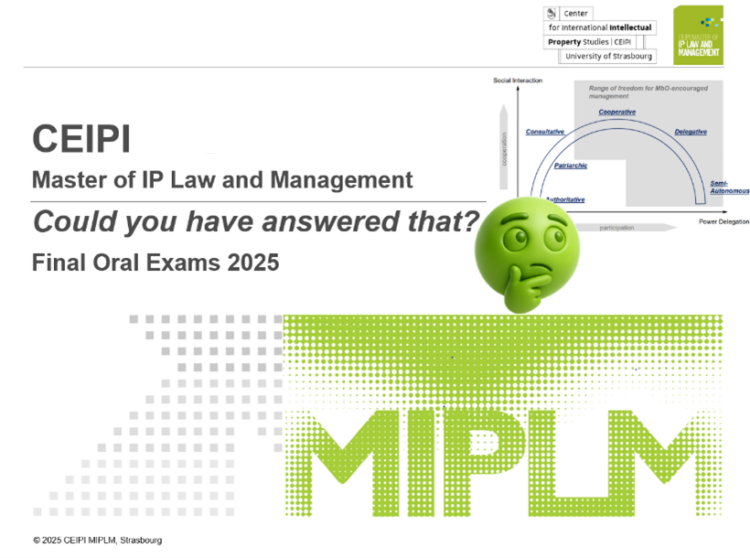Could you have answered that? Cracking the CEIPI MIPLM’25 Exam on Leadership in IP Management
Task 22 of the CEIPI MIPLM’25 exam challenges candidates to explain how leadership works in IP management. InnovaIP GmbH, a fast-growing European IP consultancy, is expanding its services across various sectors and countries. As their client base and team grow, the management recognizes that technical expertise alone is not enough to ensure sustainable success. They are now facing challenges in aligning their leadership culture with the demands of interdisciplinary collaboration, distributed teams, and innovation pressure. You are hired to design a leadership model that ensures effective team performance, motivation, and responsibility in IP management tasks.
Present a leadership concept suitable for IP experts in interdisciplinary and international teams. Describe how leadership styles can be adapted based on situational factors. Show how leadership supports motivation, collaboration, and strategic alignment in IP management.
Here you find the 🔎IP Management Glossary entry on Leadership in IP Management
Here you find the 🔎IP Management Glossary entry on Human Resource and IP Management
What the lecture on leadership teaches
The leadership module in the MIPLM program introduces a structured approach to understanding how leadership decisions affect the performance of knowledge workers in the IP field. It defines leadership as the intentional act of influencing others to achieve shared goals in a specific situation. This context-based understanding of leadership becomes especially important in IP management, where team members are often experts with high autonomy and tasks are complex and interdisciplinary.
The lecture begins by differentiating leadership from management. While management involves systems, control, and structure, leadership is about influencing people, building trust, and encouraging initiative. In the IP domain, both roles must coexist. For instance, patent portfolio planning may require management systems, while motivating a team of patent attorneys and licensing specialists across multiple countries calls for leadership.
The Situational Leadership Model by Hersey and Blanchard is introduced as a framework for adapting leadership styles to the readiness level of team members. Readiness is measured by two dimensions: competence (knowledge and skills) and commitment (motivation and confidence). Based on these, four leadership styles are identified: directing (S1), coaching (S2), supporting (S3), and delegating (S4). This model is particularly useful for IP professionals because it reflects the real-world variability of team maturity, task complexity, and organizational culture.
The module also covers the psychological mechanisms of motivation, including theories by Maslow and Herzberg, and modern concepts like Daniel Pink’s autonomy, mastery, and purpose. These insights help IP leaders understand how to keep high-performing teams engaged and productive.
A distinctive part of the lecture is the emphasis on Level 5 Leadership, a concept from Jim Collins. These leaders combine deep personal humility with intense professional will. In IP management, this leadership style allows experts to create sustainable value, foster responsibility, and build resilient teams without ego-driven decisions.
Another important theme is leadership in distributed and interdisciplinary teams. With virtual collaboration becoming the norm, the ability to build trust, align goals, and support decision-making from a distance is critical. The lecture addresses how digital tools and transparent communication can support these functions.
The lecture concludes with the role of leadership in aligning IP activities with broader innovation and business strategies. This alignment ensures that IP is not an isolated legal function, but a strategic enabler of competitive advantage.
Which IP experts explore this topic on the IP Business Academy
The IP Business Academy features several IP Subject Matter Experts who connect leadership to real-world IP practice and personal development.
- Ilanit Appelfeld: IP as a Leadership Tool
- Benjamin Delsol: IP Design as a Leadership Tool
- Maria Boicova-Wynants: IP and Leadership
- Oliver Baldus: Lean IP
Learners can find deep dives, articles, and even webinars on:
🔎 IP Management Glossary Entry: IP Manager
🔎 IP Management Glossary Entry: Change Management
🔎 IP Management Glossary Entry: Teamwork in IP Management
Sample solution to the exam question
Leadership in IP management at InnovaIP GmbH must be designed to support international, interdisciplinary teams, which are often composed of highly specialized professionals operating in different legal and cultural environments. The leadership approach must balance clear guidance, trust in expert knowledge, and the ability to motivate across borders and disciplines.
- The Situational Leadership Model offers a practical framework for navigating this complexity. In patent prosecution teams, where junior attorneys or new hires might lack full competence or confidence, a combination of directing and coaching (S1/S2) is appropriate. This ensures that tasks are completed correctly while also developing skills and commitment. In contrast, for experienced licensing professionals or IP strategists, a delegating style (S4) should be used, giving them autonomy to manage negotiations and make decisions independently, while the leader provides strategic oversight.
- To sustain team motivation, the leadership model must incorporate intrinsic motivators. For example, autonomy is critical for patent attorneys who value intellectual freedom. Leaders can support this by allowing flexibility in work methods while maintaining outcome accountability. Mastery can be encouraged through targeted learning opportunities such as attending conferences or working on challenging cross-functional projects. Purpose should be made explicit by linking IP management tasks to the company’s broader mission, such as protecting innovation that supports sustainability goals.
- Level 5 Leadership is well suited to the challenges at InnovaIP. The humility aspect is essential for leading expert teams without micromanaging. By asking questions rather than issuing orders, leaders show respect for the team’s expertise and build credibility. At the same time, professional resolve ensures that difficult decisions, such as enforcing patent litigation or rejecting weak invention disclosures, are made when necessary.
- In a distributed team setting, leadership must also be visible across virtual platforms. Regular check-ins, transparent communication, and clearly defined roles support collaboration. For example, in a global IP enforcement project, the leader may establish a central coordination platform and assign clear responsibilities to local teams, using supporting leadership (S3) to keep motivation high and address barriers as they arise.
- Strategic alignment is a final pillar of effective leadership at InnovaIP. Leaders should translate the company’s innovation and business objectives into clear IP management goals. This includes ensuring that patent filings support market entry strategies, that trademarks reinforce brand value in new regions, and that licensing terms reflect the company’s competitive positioning. Leadership here involves constant communication between the IP department and other strategic units like product development, marketing, and executive management.
In summary, a leadership model for InnovaIP GmbH must include four interlocking components: (1) adaptation to team maturity using situational leadership, (2) motivation through autonomy, mastery, and purpose, (3) long-term impact through Level 5 Leadership, and (4) coordination and communication in distributed teams. When executed consistently, this model enables IP professionals to thrive, collaborate, and contribute to the company’s strategic goals. It also reinforces a leadership culture in which legal expertise, business thinking, and innovation work hand in hand.
And that’s the kind of thinking that could help you pass the MIPLM oral exam—and more importantly, shape the future of IP management.



